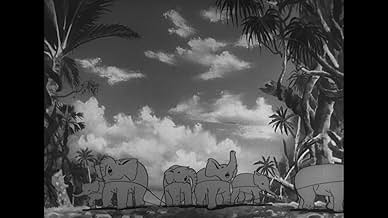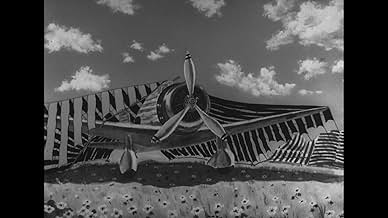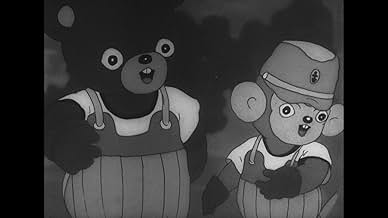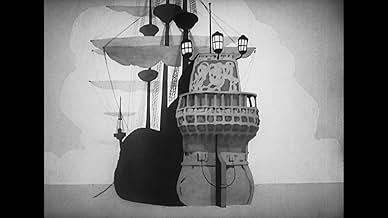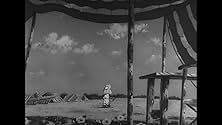Ajouter une intrigue dans votre langueThis animated film--Japan's first--was a propaganda piece made to show the Japanese public how the Japanese military had achieved such decisive victories in the South Pacific. It tells the s... Tout lireThis animated film--Japan's first--was a propaganda piece made to show the Japanese public how the Japanese military had achieved such decisive victories in the South Pacific. It tells the story of young Japanese boys from their school days to their joining the army and fighting ... Tout lireThis animated film--Japan's first--was a propaganda piece made to show the Japanese public how the Japanese military had achieved such decisive victories in the South Pacific. It tells the story of young Japanese boys from their school days to their joining the army and fighting against Japan's "enemies" and shows how the animals in the jungle--meant to symbolize the ... Tout lire
- Director
- Writer
Avis en vedette
Often acclaimed as the first anime feature, this movie is a pure propaganda piece divided into three parts. In the first, a member of the corps visits the young animals at home; in the second, they build an airfield in the jungle, aided by the local animals; in the third, they invade, and are totally victorious.
There are some lovely sequences of the fields of home, with dandelions blowing about a field; in the second, there are contemplative views of the clouded sky; the third is all action and caricatures of silhouetted Dutchmen -- labeled 'pirates' and ineffectual Englishmen. It's aimed at children as entertainment, but it's also pure propaganda. In America, almost all animal cartoons fall into the 'funny animal' variety. There are no funny animals here! Although the cutely drawn animals clearly stand in for the children of Japan, they are fierce and dedicated soldiers. Even the rabbits are fearsome and warrior-like in their aspects. Here is propaganda aimed not at adults, but at small children.
It's not so easy to be so generous about other aspects of 'Momotaro's divine sea warriors.' There are troubles in the visuals and especially the audio beyond the graininess and lack of total clarity that comes with contemporary technology and the ravages of time. There are small shots and scene of frivolous nothing that serve no apparent purpose but to pad out the length, and these also tend to look worse than the material that is plainly more purposeful. Sometimes the manner in which the camera pans across a scene is weirdly unnatural and off-putting. Elsewhere we'll have long, awkward pauses in which the meaningful audio drops out save for some ambient noise, and it quite pointedly feels like Nothing where there should be Something. This feature isn't the only instance I've ever seen of such matters, but the one other that specifically comes to mind is not a favorable comparison; one way or another, that decided lack of polish just comes across as incomplete, or crude.
Another issue dragging down the film is the notable variability of what it is presenting to us. There is a wild mix throughout these seventy-four minutes, sometimes juxtaposed and sometimes smashed together, of lighthearted silliness befitting any given cartoon that's built for children's entertainment, and the slightly more serious cartoon note of "uh oh, our friend's in trouble, we better help them." There is glorification of Japan, and accentuation of united purpose for a greater cause; performance of wartime duties, maintenance of wartime camps and equipment, and ultimately the commencement of an operation. There is also a history lesson that's narrated over its own distinct art style; an educational segment that would fit right in with any given episode of 'Sesame Street'; and musical sequences. Most of these bits and bobs are fairly well written and animated in and of themselves, and some underlying themes and bigger ideas are genuinely admirable. By putting them all together into a single movie, however, 'Momotaro' sacrifices some sense of cohesiveness.
Granted, despite the mix and match of the writing, it's not possible to mistake 'Momotaro's divine sea warriors' as anything other than the propaganda piece that it was for Imperial Japan during World War II. This core gets peculiarly waylaid every now and again, but it's the primary thrust of the title and heavily, increasingly dominates the latter half. Still, I have to wonder just how effective it could have possibly been in its purpose considering how we swing from "tee hee, chasing a hat that's caught on the wind!" to "no, for real, this is war, and here is a battle with explosions and gunfire." I know the average short from 'Looney Tunes' or 'Merrie Melodies' was also sometimes disproportionately violent, but this exists on a level all its own. Regardless, the messaging is right there for the taking - and in light of the course of history, the picture now exists as a novelty, and a vestige of another time. We can in turn appreciate and criticize the animation and writing in and of themselves, but at the end of the day, it's only the avid cinephile or a history buff who will have any reason to revisit this. Despite its nature, I don't think it's so simple as saying "'Momotaro's divine sea warriors' is bad." I think it's a film at odds with itself. If your curiosity is piqued, as mine was, then by all means check it out, but otherwise you can just not bother and get on with your day.
From what I gather from the Anime encyclopedia, which is the source of the above facts by the way, the film starts out with several animals (a monkey, a rabbit, etc) training for the Navy when on graduation the monkeys younger brother loses his siblings cap and it falls into a river, and all the animals jump down into the river to retrieve it. Then we are inexplicably transported to a Pacific Island, where another group of animals is teaching the native youngsters how to play Japanese games (good sense of Imperialism here) but soon an airplane arrives caryring Momotaro, a traditional Japanese folk hero, with his traditional allies, our friends from the Navy academy. Most of them join naval infantry, but the rabbit becomes a pilot.
The movie gets blatent when a British memo is intercepted and the little band of (probably) cute animals and fairy tale characters drive the Brits out of the island. In the final sequence we see the "divine warrior" back in Japan celebrating their victory, then playing parachute over a map of the US.
It's 64 min. which is pretty typical for a first animation feature, and would be of great historical interest, not only to disgruntle Pokemon fans, but also a superb example of self-delusion & propaganda. And I'm sure it would have it's own surreal qualities.
The negative film of "Momotaro" was found at the Shochiku Moving Picture Laboratory in Ofuna, Japan, where during WW2 director Mitsuyo Seo had been assigned by the Japanese Naval Ministry to produce a propaganda full-length cartoon on the country's defense in the Pacific islands. Momotaro, aka "Peach Boy," was a legendary character whose friends are forest animals. He leads his animal troops in the Japanese invasion of a British-held island. Japan spent a great deal of yen to produce Seo's anima after the director's previous short cartoon, 'Momotaro no Umiwashi,' a 37-minute film, was released in 1943. By the time Seo began "Momotaro's" production, the the Allies were closing in on Japan, creating a shortage of both artists and raw material to make the cels. He was forced to reuse the plastic cels, making portions of the movie somewhat muddy. Talented female artists were hired to replace the males who were conscripted to fight in the war.
Like many Japanese animators, Seo was inspired by Walt Disney's "Snow White," 'Dumbo" and Fastasia." The later is especially evident in "Momotaro" by scenes of singing animals and waving flowers in the first half, which shows an idyllic Japan, inhabited by its anthropomorphic animals possessing human behavior. In the last third Momotaro leads an army of paratroopers over the English-occupied island, panicking the British soldiers so much they are easily taken prisoners. Included among the defeated defenders was a quivering Popeye the Sailor Man, who drops his can of spinach while raising his hands in surrender.
By the time "Momotaro" was released, Japan had been extensively bombed by American planes while its forces in Iwo Jima had just been annihilated. The spirited triumphs of the Japanese in Seo's cartoon was already a fantasy to its viewers. "I suspect the film was shown primarily to the military," said historian John Dower. "The subtitles for the passages in English were clearly not aimed at children: the Kanji characters are too complicated and sophisticated." Seo's feature, coming four years after China-and Asia's-first full-length animated film, 1941's "Princess Iron Fan," had a profound on the future of Japanese anime. Osamu Tezuka, who has been called the Disney of Japanese animation, remembers seeing the feature in his mid-teens. "I sat in the freezing Shochiku-za movie theater, which had somehow survived the bombings, and watched 'Momotaro' and I was so impressed, I began weeping uncontrollably," wrote Tezuka. "The lyricism and childlike spirit in all the reels were like a warm light, illuminating my mummified spirit, depleted of both hope and dreams. I swore then: 'I will someday make my own animated films.'"
Le saviez-vous
- AnecdotesThis was Japan's first anime (animated feature).
- Autres versionsThere's a scene where Bluto and Popeye surrender to Japanese forces, which was removed from some home video versions. It was reinstated in the 2K restored version.
- ConnexionsFeatured in Cartoons Kick Ass (2000)
Meilleurs choix
- How long is Momotaro, Sacred Sailors?Propulsé par Alexa
Détails
- Durée1 heure 14 minutes
- Couleur
- Mixage
- Rapport de forme
- 1.37 : 1
Contribuer à cette page


